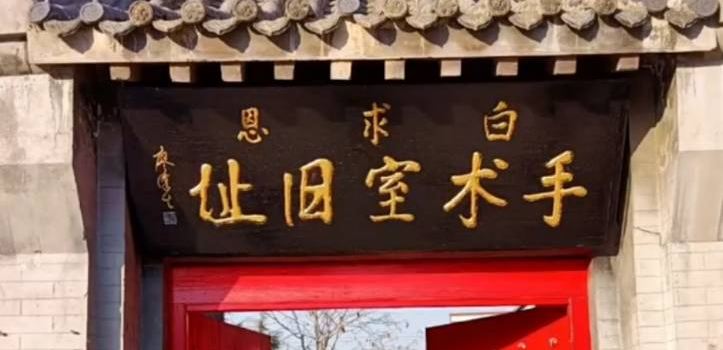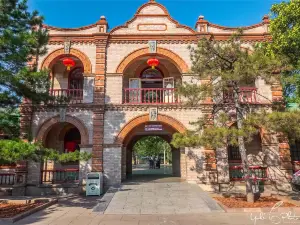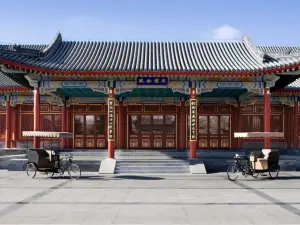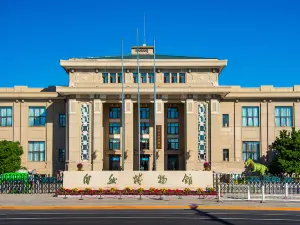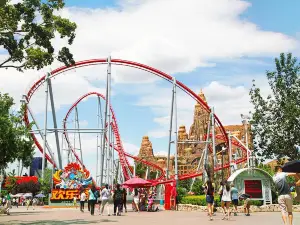Photos
Hejian
2025 Hejian Travel Guide: Weather, Transportation, Popular Attractions, and Everything You Need (Updated 2025 2)
About Hejian
View Local Experiences on Map
Things to do in Hejian
What to Do
Looking for things to do in Hejian? We provide up-to-date info on everything from must-see scenic spots to local hangouts.
View More
Where to Stay
Discover the most popular places to stay in Hejian, complete with recommendations from fellow travelers and special hotel offers
View More
What to Eat
Want to eat like a local? Don't miss out on these top Hejian dishes and foodie spots.
View More
Hejian Moments: Through Travelers' Eyes
Post

The First Mansion in the South of the Capital
Charlotte Parker

A Day Tour of Hejian Prefecture Office: Experience Eating, Drinking, and Playing
AWV. Ava 3839
View More
What People Are Saying About Hejian
Write a Review
Ancient Government Office of Hejian
品赏风景
Baiyangdian Lake
118***57
The Zhili Governer's Office
我叫金太阳
Ancient Lotus Flower Pond
墨染梦落
Lotus Grand View Garden
Anonymous User
Xiong'an Impression
麻辣小龙虾
Paleozoological Museum of China (Baoding Natural History Museum)
yjw2000
Cangzhou Garden Expo Park
Anonymous User
Ranzhuang Tunnel Warfare Site
我么哒
Cangzhou Museum
杰杰陶TAO
Best of Hejian
Popular Types of Attractions in Hejian
Historical attractions | Cultural institutions | Specialty exhibition halls | Museums | Science & technology museums | Nature and wildlife | Natural scenery | Mountain climbing | Beaches and shores | Sightseeing tours | Night view | Boat tour | Cable car | Leisure activities | Farms and pastures | Camping · Campsites | Spa/massage | Exhibitions & events | Performances | Exhibitions | Concerts | Parks | Amusement parks | Water parks | Ice and snow parks | Outdoor activities | Mountain climbing | Rock climbing | Shooting | Water sports
Popular Attractions in Hejian
Popular Ranked Lists
Top 3 Premium Hotels in Chhattisgarh | Top 5 Best Things to Do in Weinan | Top 17 Local Restaurants in Bali | Popular Premium Hotels in Groznyy | Popular Best Things to Do in Jiashan | Top 5 Best Things to Do in Ulanqab | Popular Luxury Hotels Near Lumut | Top 19 Local Restaurants in Venice | Top 19 Local Restaurants in Xi'an | Popular Best Things to Do in Longyou | Top 4 Best Things to Do in Cixi | Popular Luxury Hotels Near Sadikbey | Popular Best Things to Do in Ghajnsielem | Popular Luxury Hotels Near Key West | Top 15 Local Restaurants in Taipei | Popular Luxury Hotels Near Plymouth | Popular Best Things to Do in Baiyin | Popular Luxury Hotels in Atlanta | Top 7 Best Things to Do in Chifeng | Popular Best Things to Do in Suining | Popular Best Things to Do in Xinchang | Popular Best Things to Do in Fujinomiya | Popular Luxury Hotels Near Santa Margherita Ligure | Top 4 Premium Hotels in Gyeonggi-do | Popular Luxury Hotels Near Leipzig | Top 9 Premium Hotels in Andhra Pradesh | Top 4 Best Things to Do in Changzhi | Popular Luxury Hotels Near Healdsburg | Popular Luxury Hotels Near Cesenatico | Top 3 Best Things to Do in Jiangmen
Popular Restaurants in Hejian
苗颖竹荪鹅(曙光西路店) | 瀛州孙记驴肉火烧(河间总店) | HE JIAN LAO HAN LV ROU HUO SHAO | 李春秋驴肉火烧(京广线店) | 白鸽面包房(新华中路店) | 恩赐火烧驴肉总店 | 驴火村驴肉火烧(瀛洲首府店) | 兴丰农场 | 壹品厨房东北铁锅炖(东垣北街店) | 高玛纳驴肉火烧(河间店) | Qinglin Full Donkey Feast | 功夫驴驴肉火烧(城垣东路店) | XIAO YAN ZI CAN TING | 肯德基(河间店) | WANG CHAO FAN DIAN | 肥三香辣虾(总店) | 老孙头驴肉火烧(总店) | 蛤蟆吞蜜驴肉火烧店(总店) | 麦当劳(河间城垣路店) | Malimalaxiangguo qingzhen | 京面佳面馆(河间店) | 爱辣屋 | Haolunge (tongchuang) | 万贯驴肉火烧(河间总店) | 馨鑫饭庄 | 聚鑫鸽子王 | 香格园一锅出(学府北街店) | 永顺火烧驴肉 | 巴盛重庆火锅(诗经路店) | 小叮当蛋糕房
Popular Destinations
Wuhan Travel | Iloilo City Travel | United States Travel | Changsha Travel | Rochester Travel | Switzerland Travel | Hawaii Travel | Guangzhou Travel | Abu Dhabi Travel | Jiangxi Travel | Toronto Travel | Gold Coast Travel | Washington D.C. Travel | Moscow Travel | Bratislava Travel | Fukuoka Prefecture Travel | Fort Bragg Travel | Yeosu Travel | Hull Travel
Recommended Attractions at Popular Destinations
Bangkok attraction near me | Manila attraction near me | Tokyo attraction near me | Taipei attraction near me | Hong Kong attraction near me | Seoul attraction near me | Kuala Lumpur attraction near me | Los Angeles attraction near me | Shanghai attraction near me | New York attraction near me | Shenzhen attraction near me | Osaka attraction near me | Singapore attraction near me | London attraction near me | Guangzhou attraction near me | San Francisco attraction near me | Beijing attraction near me | Macau attraction near me | Bali attraction near me | Jakarta attraction near me | Paris attraction near me | Ho Chi Minh City attraction near me | Istanbul attraction near me | Phuket attraction near me | Chicago attraction near me | Seattle attraction near me | Toronto attraction near me | Orlando attraction near me | Cebu attraction near me | Chiang Mai attraction near me
More Things To Do in Hejian
China | 5G/4G eSIM | Day Pass/Total Package | 24H | 1-30 days | QR code | China 5G eSIM | Daily 500MB – Total 50GB | 1-30 Days | QR code | China, Hong Kong, Macau 5G eSIM|High-speed data 500MB/Day – Total 20GB|1-30 Days|QR code | China/Hong Kong/Macao/Taiwan | 5G/4G eSIM | Day Pass/Total Package | 24H | 1-30 days | QR code | Global (66 countries) eSIM | Data packages | 1-7 days | QR code | Asia 8 countries eSIM 4G/5G high-speed network QR code | Mainland China eSIM 4G/5G high-speed network QR code | Mainland China eSIM | 5G High-Speed Data for Travel and Business, Flexible Duration Options, QR Code. | Asia 14 Countries 4G eSIM | Daily data | 1-30 days | Natural day | QR code | China, Hong Kong, and Macau eSIM | Mainland China/Hong Kong/Macau Coverage, High-Speed Data for Travel and Business, Flexible Duration Options, QR Code. | Global 92 Countries 4G/5G eSIM | Day Pass/Total Package | 1-30 Days | QR Code | China Mainland + Macau 5G/4G eSIM QR Code by China Unicom | [China Mainland] eSIM | SIM to China | 8GB 8days 4G high speed | Global 5G Prepaid eSIM: 108 Regions, 1-30 Days, Tethering Support, Instant QR Setup | Asia multiple Regions | 5G eSIM | 1-30 days | Hotspot sharing | Quick installation | QR Code | AIS SIM2Fly Global 148 Countries 4G/5G eSIM |8 Days Total 6GB|QR code | Asia (31 countries) eSIM | Day Pass/Data package | 8-30 days | QR code | 【Mainland China】4G Internet Card|China Unicom|High-speed Data SIM Card|Selectable Days|Plug and Play|Pick Up at Hong Kong Airport | 157 countries around the world 4G/5G eSIM|Total data package 1GB-50GB|3-30 days|QR code | [China, Hong Kong and Macau] 4G network | Unlimited traffic | Self-pickup at the airport | WiFi rental, high-speed traffic, shared by multiple people, ready to use at startup, 12H standby, 24H customer service | Global eSIM | 5G/4G | Total Package&Day Pass | Natural Day | 1-30days | QR code | [Limited time 10% off] [5G SIM card] China Mobile 5G SIM card | Unlimited calls and smooth Internet access (self-pickup at Shanghai Pudong T1/T2) | [Mainland China] 5G | eSIM Internet Card | China Mobile CMLink | 3-15 days optional | Ready to use | Hotspot supported | QR Code | 【Mainland China, Hong Kong, Macau】4G Internet Card|China Unicom/Hutchison/CTM|High-speed data SIM card|Selectable number of days|Insert and use| | Central Asia (30 countries) eSIM 4G/5G high-speed data, no need to remove the card QR code | [Limited time 10% off] [5G SIM card] China Unicom 5G SIM card | Can make calls, smooth calls, and smooth Internet access (self-pickup at Shanghai Pudong T1/T2) | Mainland China + Hong Kong + Macau|eSIM| Optional days |Total Internet traffic/day|4G/5G|QR Code|Send confirmation immediately | China/Hong Kong/Macau eSIM 4G high-speed network QR code | Mainland China, Hong Kong & Macau 5G Travel eSIM | Flexible 1-30 Days Plan | Instant Setup via QR Code | China, Hong Kong, Macau 4G SIM Card (HK, Macau, Taiwan, China Delivery Only)
About
Payment Methods
Our Partners
Copyright © 2025 Trip.com Travel Singapore Pte. Ltd. All rights reserved
Site Operator: Trip.com Travel Singapore Pte. Ltd.
Site Operator: Trip.com Travel Singapore Pte. Ltd.



